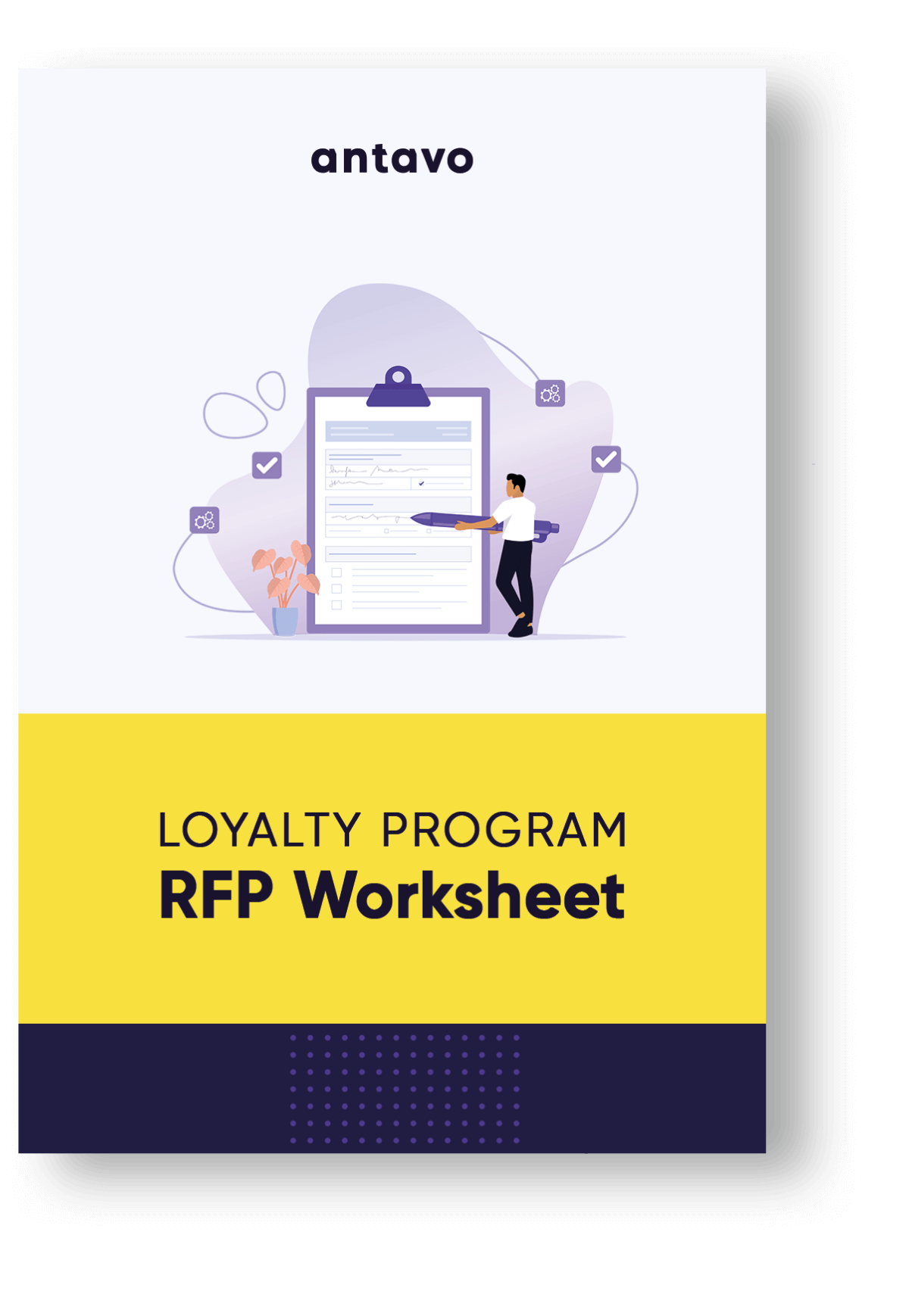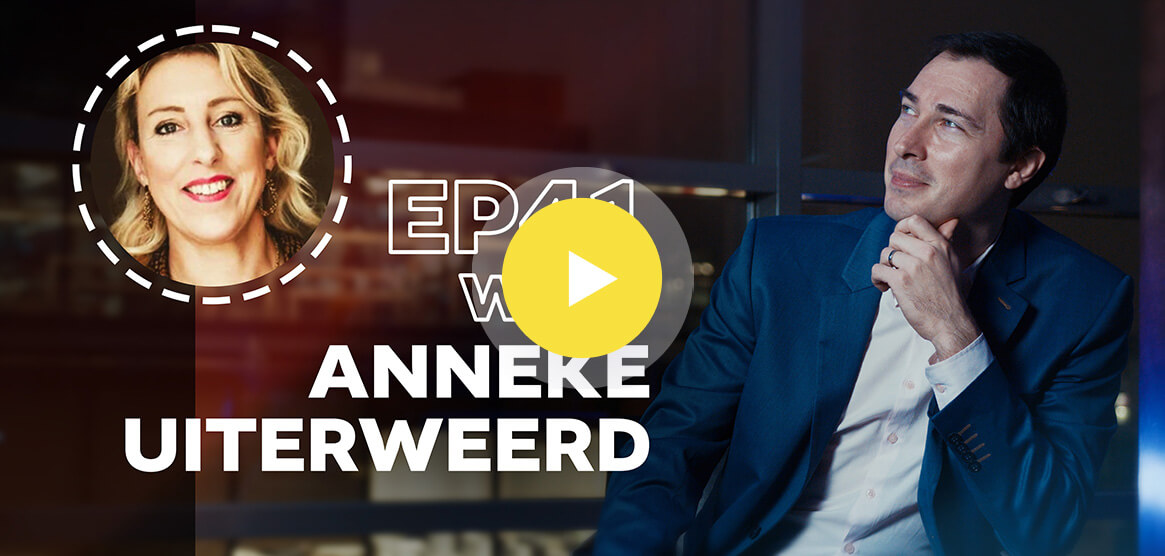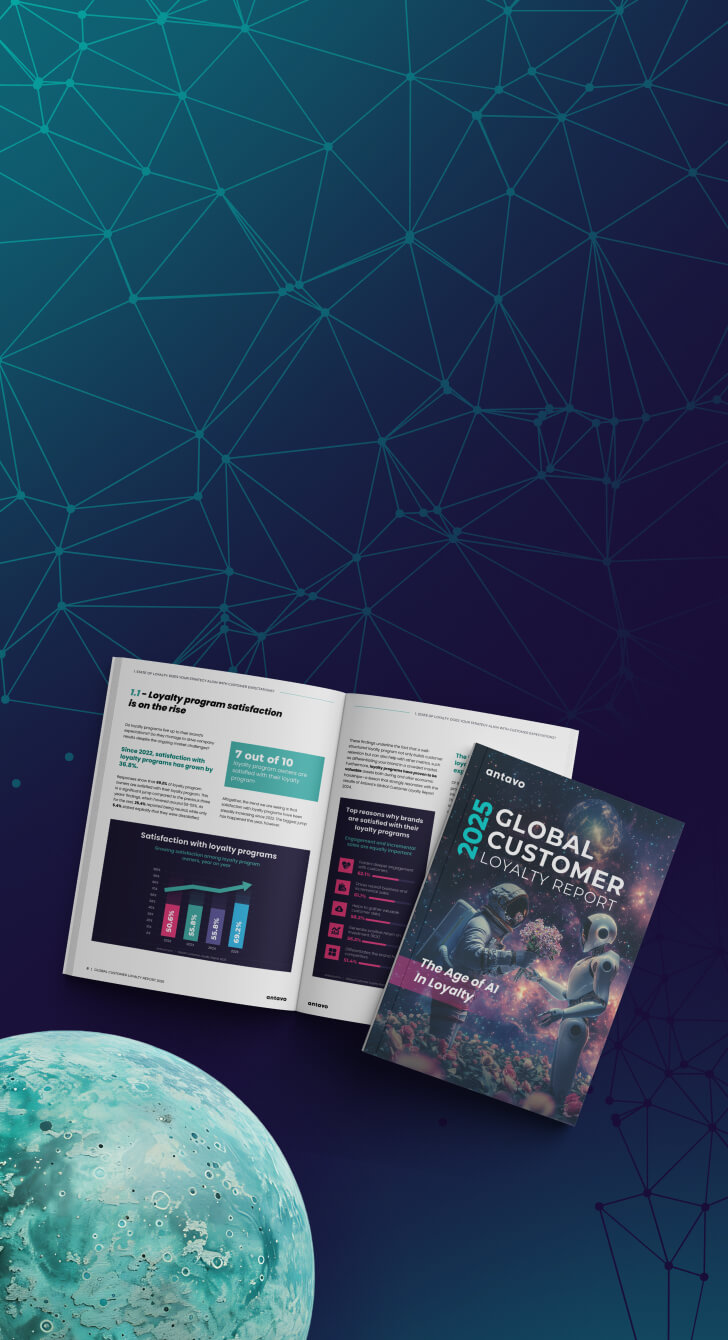During this week’s episode of Antavo’s Loyalty Stories video podcast, our expert guest is Anneke Uiterweerd, Digital strategist and Business developer at Springbok Agency.
The interview for this podcast has been a valuable source for Antavo’s Global Customer Loyalty Report 2024. Make sure to download it for over 30 statistics on loyalty program trends.
This time on the podcast, we discussed the evolution of loyalty programs and their shift towards community-building and mission-driven strategies. Anneke highlights her favorite initiatives from industry-leading brands like Hunkemöller, Nike, or Patagonia. She also shares her thoughts on how technology, personalization, and ESG initiatives shape modern loyalty programs.
Highlights from our conversation with Anneke:
- Community-centric loyalty programs are in the lead right now
- The way to activate members is to create purpose-driven experiences that inspire
- App-based programs, personalization powered by AI, and integrating digital wallets are key features for modern loyalty strategies
- Virtual rewards, gamification, and metaverse experiences are becoming essential
Learn more:
- LinkedIn profile of Anneke Uiterweerd
- Springbok Agency website
- Learn more about Sportswear Loyalty Programs
- Book a demo with Antavo’s loyalty experts
Gabor
Hi and welcome to Loyalty Stories, that is Antavo’s podcast on customer loyalty and loyalty programs. I am Gabor Vigh, one of the Partnership Managers at Antavo, and Antavo is a technology company that empowers loyalty programs all over the world. We help various great businesses such as KFC, Benefit Cosmetics, and very well known global automotive and fashion brands, airports and so on.
In this Loyalty Stories podcast, we dive into the trends around loyalty programs and customer loyalty. We talk with industry experts all around the world to pick their brains to learn what’s new and what’s next for loyalty programs. Today’s guest is Anneke Uiterweerd, one of the strategic marketing consultants at Springbok Agency based in the Benelux region, but working with international brands.
Springbok helps its customers to achieve sustainable growth by focusing on the brand’s mission, goal settings and strategic initiatives to create brand and customer loyalty. So, hi Anneke, how are you?
Anneke
Goedendag in Dutch. I’m good. How are you?
Gabor
Thank you, and very well. Thank you so much for accepting our invitation for today’s loyalty session. I am very pleased to have you on board. We had a couple of conversations earlier about loyalty that made me very, very excited. But first, before we dive into these loyalty topics that we have on the agenda today, may I ask you to briefly introduce yourself to our audience?
Anneke
Yes, perfect. Yes, I’m Anneke Uiterweerd and I’m indeed a strategic consultant at Springbok Agency and I’ve been working for Springbok for almost one and a half years, two years, almost two years actually. But before I turn to the agency side of work, I worked for different businesses, always in CRM slash loyalty management positions.
So, some nice brands I worked for were Tommy Hilfiger, Hunkemöller, which is a European luxury retailer. I’ve also worked for Unilever, which is FMCG, and for Bol.com, which in the Netherlands and in Belgium is quite well, it’s actually the monopolist and the competitor of Amazon. And in all those roles, I had CRM as loyalty and digital marketing as a red thread running through my career.
Gabor
Oh great, so you have seen a lot of loyalty programs as well, I guess because these brands have got some loyalty programs for their customers. So that makes me ask this question, what would you name as your favorite loyalty program and why?
Anneke
Yes. Well, there are two. I know I need to pick one, but one is of course, one that I built myself with the team at Hunkemöller. I initiated a fully new loyalty program over there. They were having an early reward mechanism in place where they gave consumers points in return for shop credit. But that was actually the only feature or the only burn and burn rule that was built in there.
And we saw the engagement declining. We saw the active membership declining. We saw also the people that downloaded the app to use the loyalty program declining. So there was a need for a new loyalty program. And I worked on a fully new program, including tiers, gamification, experiential rewards.
And we also looked into making the loyalty program omnichannel available. So both in the brick and mortar source, as in the app, as in the website, it needed to be one frictionless single sign on the journey for the customer. So I’m very proud of that.
But my most favorite loyalty program where I think is really is a strong loyalty program, that’s the Nike loyalty program. I think that’s a really cool, good differentiator for the Nike brand. And that’s because they support and activate the community of sports lovers or running lovers, as you would say, in all in very diverse means of reward system that they have.
And they just focus on everything else in the context of that consumer, in his head, everything else with that. I mean his or her lifestyle, his or her interest, his or her peers, every aspect of the adult program is about the consumer and not so much about the brand or the products.
And I think that’s also the future of good loyalty programs that they make. Of course, the brand grow big, but also make the brand grow good. So really having an impact through their members on a better world, or in this case, on a healthier world.
Gabor
Great, yeah, I know that there are a couple of fans of the Nike loyalty program here at Antavo as well. In the very first Global Customer Loyalty Report that we launched for 2022, we made the analysis on their program. So, yes, I completely understand why you picked that one as favorite.
Anneke
Yes, and I’m a runner as well, so that’s of course a little bit biased.
Gabor
Great, great stuff. And because you have been in the industry for quite a while now, Anneke, what would you say, what were the biggest changes in the recent years that you’ve seen on the field of loyalty?
Anneke
There are so many. Every time I was initiating or managing or optimizing the loyalty programs within the companies I’ve worked for and also within the clients I now work for within the Sprinbok Agency, I always see it’s a martech project that you’re running, right? It’s not about the rewards and the benefits.
It’s more and more about the technology that’s super important and the data within the technology or the data that’s managed within. More and more I see also with clients of Springbok that the need for identifying consumers, also with the whole first party data, that’s so crucial as almost a business asset of most companies.
It’s crucial to get the first party data in and there then lot of the programs often are used for that. So what I see is that yeah the technology is super important and technology is a very broad term but there’s of course AI which helps to affect more efficiently and effectively differentiate the proposition towards customers. So I think that’s especially the personalization so much more relevant since COVID because we tend to see that due to the COVID pandemic, that consumer behavior has significantly changed.
So in order to adapt to that, you need to be vary, you need to spend a lot of time in finding out what kind of behavior do we see, how can we anticipate on that behavior and define the next best action within our loyalty program. And I think AI and the whole predictive models that come with it really are helpful to do that in an efficient, effective way.
Other things in terms of technology, of course, that most loyalty programs are these days are app-based. There’s no way around launching a loyalty program that’s just in a website or just in the store. It needs to be on the channel. So it also there is a technology influence that I see. But the app-based loyalty programs, yeah, there has been a real clear shift, I think, to the app-based loyalty programs.
And also to using more of your own channels, also with regards to first party data, the consent in and also having own channels enables you to again personalize the message. So digital channels, own digital channels are super important and really helpful to build yeah to build a good lot of the program from. Next to that there are a couple of other developments.
I think what I see is that like I just said building big, make big brands grow is one of our payoffs at Springbok. It’s of course important, loyalty programs really help to create retention and brand loyalty. But it’s also important these days to make the brands grow good. And with that, I mean that the do-good factor within loyalty programs and activating your members to do something good for the world and also sustainability for influence, of course, is also there.
That makes it super important for brands to address this within the loyalty program. So how can we activate and support our members in a way that they can activate and support others or environmental issues or anything that helps to make the world a better place. I think that’s super important to address.
Gabor
Okay, so like communities and some kind of common causes like ESG, like environmental, social or governments, right?
Anneke
Yes, and the donations, being able to spend your points on donations or NGOs, that’s I think a really clear environment. From a data perspective, I also see a lot of issues but also a lot of solutions in terms of data privacy and data security. And I think loyalty programs should and could help with that to make every data collection as transparent as possible and also make transparent how this data is used to make the experience more relevant and more enticing for the customers.
I think that’s where we still have to build a better practice within our loyalty programs to really make sure that we don’t gather or use data in a subconscious way in terms of consciousness from a customer perspective. And then last but not least, we already touched upon it, I think, partnership programs.
I strongly believe also referring back to the community view that I have on loyalty programs and they should support and activate communities, that it’s also important to connect with other brands that can help to support and activate your members within your loyalty program. Because I do not believe in strong branded programs like the Nike program is also not about Nike.
Of course, it’s a Nike program, but it’s more about the sports community. They want to support and activate and bring in contact with each other. Also another very important factor of community loyalty programs. Personally, I’m very interested in all the loyalty program propositions, as you could call them in the metaphors.
So I see so many developments in the metaverse around which can be defined as loyalty programs. They’re not called loyalty programs but it really feels like also building communities in there, giving tokens so people are part of a loyalty program instead of a participator. They are really becoming shareholders of the program and the brand. I am really keen to see what that brings to us, what kind of innovations will come from that.
Gabor
Great, yeah. I remember when I first heard about like metaverse and NFTs and kind of like points as cryptocurrencies for brands. It was kind of like surprising for me back in the day. Did it surprise you or did you find other kind of like loyalty solutions or new programs that kind of like surprised you in the past two or three years?
Anneke
Well, no, but I felt like half a year ago, almost a year ago actually, I felt and I told also my colleagues at Springbok, you know we need to deep dive and tap into our loyalty proposition because we were helping clients with their loyalty programs, but I felt there was a transition going on from like earn and reward mechanisms to membership, member versus non-member solutions, towards more there is a stronger focus on brand love and brand building, and also on customer value and customer attention, but more on the brand building and creating those brand ambassadors.
And I know that has been, of course, a goal for many loyalty programs from the start, but I think with the community concepts of a loyalty program, that becomes reachable, that ambition becomes reachable. And I also felt that, a community is by definition, if it becomes scalable, it’s by definition an online community. So I felt there was a need for creating online communities somewhere in some environments.
So when the meta first came and I saw all these brands tapping into their building loyalty communities and also I felt that these communities should be supported and should be helped to get in action, to do some good, to activate others, to realize improvements in their surroundings or in other people’s lives.
And I felt that the only way you can ask your members to start being active and to be a front runner for something, then you also have to make them a part of your business and not just a participant in the business, not just doing purchases. I think I would like to quote Yvon Chouinard, which was the CEO of Patagonia, and he says, true loyalty lies in the intersection of when brands really adapt and focus on customer needs, but also make sure that they support and activate those customers.
It’s a huge asset and that member base is actually the most important asset of a company, I would say. Customer data, but specifically loyalty members in the customer data. And that asset needs to be scaled. And the way to scale it is to make people part of the journey, the company’s journey, the company’s vision and the company’s mission.
That’s also why I called the proposition from Springbok, called it mission-driven loyalty, because I think it starts with the brand mission. If you have your brand mission, you can define your customer mission. If you have your customer mission, then you go and define your loyalty concept.
Gabor
Great, and now that we talked about the past and if you look into the, I would say, bright future for the programs, what are, let’s say, the two main trends that you think it’s coming up in the loyalty strategy or in loyalty programs in the next years?
Anneke
I think the big idea in 2020 in loyalty marketing is community. I believe reaching consumers in the communities they are part of is actually the way forward for loyalty programs. And for brands as well. Brands need to be able to fulfill the needs of their customers and really make them express their community membership.
That for me is the future of loyalty programs. Again, not participating in a program and not just earning things because you do something, but really intrinsically motivate your members to step up and do something good.
Gabor
Great. And what do you think, Anneke, how a loyalty technology company or vendor should support these kind of programs? What are those features and functionalities that are required?
Anneke
Yes, well if you look at communities, especially if you look at the idea that I have about the metaverse communities and loyalty programs within there. And I see three things that are really valuable if you want to build a loyalty community like that. One is convenience through a digital wallet. There’s always, of course, the purchase side of things and the retention side of things. So connecting a digital wallet and being able to do so is super important.
Secondly, the personalization. So being able to personalize the experience and therefore using data in a very intelligent way and using predictive models for that is I think the second most important feature that you need to be able to enable. And thirdly, that stakeholdership. Meaning looking into technologies like NFT tokens, the tokenization part of things is super important to set up.
And if you look at really like specific practical examples of features or characteristics as part of the, yeah, the new loyalty programs 2.0. I would say it’s being able to integrate virtual loyalty points or tokens like NFTs. Also having customizable avatars and accessories because you want to express yourself as a member. Virtual events.
So a lot of virtual rewards and virtual benefits come into place, I think. Virtual store integration, so you can also visit the retail within the community and also with a digital wallet, not only being connected to the brand, the retail environment, the virtual environment of the brand, but also the environment of other brands.
So that’s a bridge, I think, towards the partnership side of the model, able to connect partners to your brand and also make it possible for consumers to just shop on that virtual high street with not only your brand but also with other brands and using the data that comes from it again to optimize the experience.
Then gamification, I think, is something that really is super important, like leaderboards and challenges. That’s also very present in the metaverse, if you look at the lots of communities that are built there. And last but not least, metaverse analytics, and that’s still a new ground to explore, but it becomes important, of course, to see what kind of engagement you want to measure in those communities.
Because it’s not only about the purchase or the channel engagement, it’s also maybe about the referral activities, the donation to good causes, or the user generated content coming from your community. You want to measure those kinds of things. Very important. What else? Yeah, of course the UX is very important.
Gabor
Great. And when it comes to technology, what is your generic opinion? Buy or build in-house?
Anneke
I would say buy. Yeah, yeah. Unless it’s not customizable, then I could I would say build. But like I said, it needs one of the key assets, key features of a technology platform should be that it’s customizable. Because otherwise it’s not relevant to the specific target audience of the brand. So yeah, and to be able to customize, you need a very agile or flexible environment, which is by definition, I think something you need to buy.
Gabor
Great, great. Thank you, Anneke. Is there anything else in mind that you would like to share with the audience or give some advice when it comes to loyalty programs or loyalty implementation?
Anneke
Well, it’s more like a feeling that I have that, you know, am I the only one that thinks that the metaverse communities will be the next best thing in loyalty marketing or in loyalty program propositions. Sometimes I feel a bit like a lot of people say, you know, this is something that, yes, it is there, but there’s also talk about metaverse not becoming very successful.
And maybe it’s not the metaverse, but I wonder if there are other loyalty marketers out there that also look into the community concepting, concepts of loyalty programs, the way I look at it and explained it. And what I currently see is, if you look at these online communities, that there is a strong visualization of a retail environment.
So a lot of these brand like Adidas in the metaverse has like a retail store and you walk through it and yes there is an avatar that’s helping you out with choosing the right t-shirt or shoes but it’s still almost like a translation of brick and mortar store into the metaverse and I wonder if that’s what we are aiming for as a brand.
Should we be more looking into what drives the people to like the brand or to love the brand. And that’s probably for JBL, one of our customers, that’s more than just the music boxes or the earplugs. It’s more about, I love music. And it helped me to engage more with peers that like the same music and yeah, amplify the experience that I have when I listen to music or go to a festival. I believe that’s far stronger to build loyalty programs or propositions on than just looking at the retail or the commercial side of things.
Gabor
Great, lovely. Thank you very much, Anneke, for being here with us today and sharing your thoughts. I really enjoyed our conversation. I had a couple of favourite parts of today’s discussion, definitely the community part, the importance of building communities to gather people around mutual or common cause, motivate, activate members to do something or just
connect them as you mentioned with JBL.
Also you mentioned Patagonia, I think there are big fans at Antavo for their program as well, so they are doing it brilliantly. And also when you mentioned about your quota that you named your loyalty offering as a mission driven loyalty. I think this is a really great approach at Springbok that also I am seeing as well in the past.
So thank you very much Anneke for being here with us and for the viewers wherever you listen to us or watch us, shall it be a podcast platform, YouTube or LinkedIn, please like this podcast, subscribe to the channel so this way you will see when the next episode is out, but also tell us what you think about loyalty in the comment section below.
Visit antavo.com to discover next generation loyalty software. Antavo is the loyalty technology vendor that is used by global companies like KFC, Benefit Cosmetics, global automotive, fashion, and airport companies all over the world.
But also visit Springbok website at springbokagency.com or Anneke’s LinkedIn page to find out more exciting details of her work.
Thank you and see you on the next one. Bye for now!










